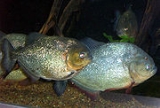
Piranha
Overview
Family (biology)
In biological classification, family is* a taxonomic rank. Other well-known ranks are life, domain, kingdom, phylum, class, order, genus, and species, with family fitting between order and genus. As for the other well-known ranks, there is the option of an immediately lower rank, indicated by the...
Characidae
Characidae
The Characidae, characids or characins are a family of freshwater subtropical and tropical fish, belonging to the order Characiformes. The name "characins" is the historical one, but scientists today tend to prefer "characids" to reflect their status as a by and large monophyletic group at family...
in order
Order (biology)
In scientific classification used in biology, the order is# a taxonomic rank used in the classification of organisms. Other well-known ranks are life, domain, kingdom, phylum, class, family, genus, and species, with order fitting in between class and family...
Characiformes
Characiformes
The Characiformes are an order of ray-finned fish, comprising the characins and their allies. Grouped in 18 recognized families, there are a few thousand different species, including the well-known piranha and tetras.-Taxonomy:...
, an omnivorous freshwater
Freshwater
Fresh water is naturally occurring water on the Earth's surface in ice sheets, ice caps, glaciers, bogs, ponds, lakes, rivers and streams, and underground as groundwater in aquifers and underground streams. Fresh water is generally characterized by having low concentrations of dissolved salts and...
fish
Fish
Fish are a paraphyletic group of organisms that consist of all gill-bearing aquatic vertebrate animals that lack limbs with digits. Included in this definition are the living hagfish, lampreys, and cartilaginous and bony fish, as well as various extinct related groups...
that inhabits South American river
River
A river is a natural watercourse, usually freshwater, flowing towards an ocean, a lake, a sea, or another river. In a few cases, a river simply flows into the ground or dries up completely before reaching another body of water. Small rivers may also be called by several other names, including...
s. In Venezuela
Venezuela
Venezuela , officially called the Bolivarian Republic of Venezuela , is a tropical country on the northern coast of South America. It borders Colombia to the west, Guyana to the east, and Brazil to the south...
, they are called caribes. They are known for their sharp teeth
Tooth
Teeth are small, calcified, whitish structures found in the jaws of many vertebrates that are used to break down food. Some animals, particularly carnivores, also use teeth for hunting or for defensive purposes. The roots of teeth are embedded in the Mandible bone or the Maxillary bone and are...
and a voracious appetite for meat
Meat
Meat is animal flesh that is used as food. Most often, this means the skeletal muscle and associated fat and other tissues, but it may also describe other edible tissues such as organs and offal...
.
Piranhas belong to the subfamily
Family (biology)
In biological classification, family is* a taxonomic rank. Other well-known ranks are life, domain, kingdom, phylum, class, order, genus, and species, with family fitting between order and genus. As for the other well-known ranks, there is the option of an immediately lower rank, indicated by the...
Serrasalminae
Serrasalminae
Serrasalminae is a subfamily of fish within the family Characidae. The name means "serrated salmon family", which refers to the serrated keel running along the belly of these fish.-Common names:...
, which also includes closely related omnivorous fish such as pacu
Pacú
Pacu or pacú is the common name of several South American fishes.PACU, Pacu or pacú may also refer to:*Piaractus mesopotamicus , a South American ray-finned fish that is endemic to the Paraguay-Paraná River basin*Tambaqui , known as black pacu, black-finned pacu, giant pacu*Philippine Association...
s. Traditionally, only the four genera
Genus
In biology, a genus is a low-level taxonomic rank used in the biological classification of living and fossil organisms, which is an example of definition by genus and differentia...
Pristobrycon
Pristobrycon
Pristobrycon is a genus of piranhas.Pristobrycon contains five species. However, this genus is not monophyletic. No single morphological feature has been found that completely diagnoses this genus. P...
, Pygocentrus
Pygocentrus
Pygocentrus is a genus of the piranha family Characidae. All are native to tropical South America. It is mainly located in the Amazon, San Francisco and Orinoco rivers. Three especies are fully recognized. P. cariba in the Orinoco; P. nattereri Kner, 1869 in the Amazonas: and P. piraya in the San...
, Pygopristis and Serrasalmus
Serrasalmus
The genus Serrasalmus consists of several species of piranhas in family Serrasalmidae of the family Characidae. They are collectively known as pirambebas; the "typical" piranhas like the Piraya Piranha are nowadays placed in Pygocentrus....
are considered to be true piranhas, due to their specialized teeth.
Unanswered Questions
Discussions

